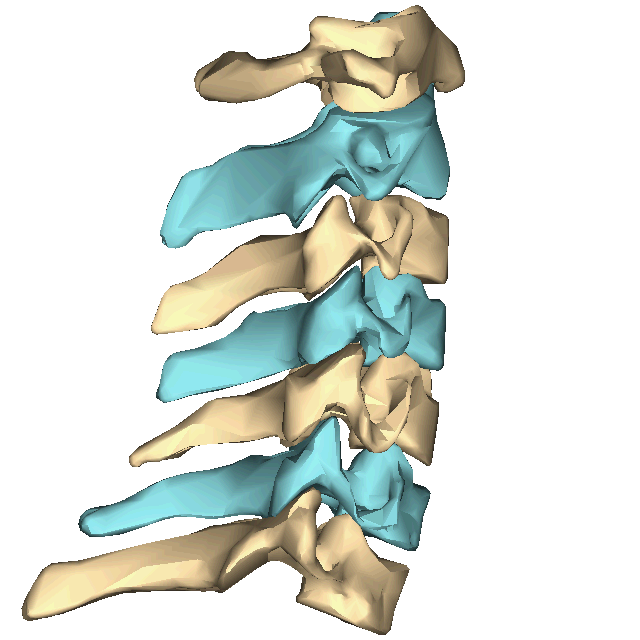Cervical spine disorder
Editor-In-Chief: Prab R Tumpati, MD
Obesity, Sleep & Internal medicine
Founder, WikiMD Wellnesspedia &
W8MD medical weight loss NYC and sleep center NYC
| Cervical spine disorder | |
|---|---|

| |
| Synonyms | N/A |
| Pronounce | N/A |
| Specialty | N/A |
| Symptoms | Neck pain, stiffness, headache, radiculopathy, myelopathy |
| Complications | Chronic pain, neurological deficits |
| Onset | Varies |
| Duration | Can be chronic |
| Types | N/A |
| Causes | Degenerative disc disease, trauma, arthritis, herniated disc |
| Risks | Age, smoking, poor posture, repetitive strain |
| Diagnosis | Physical examination, imaging studies (X-ray, MRI, CT scan) |
| Differential diagnosis | Tension headache, migraine, fibromyalgia |
| Prevention | Ergonomics, exercise, smoking cessation |
| Treatment | Physical therapy, medication, surgery |
| Medication | NSAIDs, muscle relaxants, steroids |
| Prognosis | Varies |
| Frequency | Common |
| Deaths | N/A |
Cervical Spine Disorders encompass a wide range of conditions that affect the cervical spine, which is the upper part of the spine located in the neck. These disorders can result from degenerative diseases, trauma, congenital abnormalities, tumors, and infections. The cervical spine is made up of seven vertebrae, labeled C1 through C7, and serves as a critical structure for supporting the head, protecting the spinal cord, and facilitating a wide range of head and neck movements.
Causes and Risk Factors[edit | edit source]
Cervical spine disorders can be caused by several factors, including:
- Aging: Degenerative disorders such as cervical spondylosis are more common in older adults.
- Trauma: Accidents or injuries can lead to fractures, dislocations, or other cervical spine injuries.
- Repetitive Stress: Activities that involve repetitive neck motion or prolonged periods of sitting or standing without ergonomic support can contribute to cervical spine disorders.
- Genetic Factors: Some individuals may be predisposed to certain conditions, such as congenital cervical stenosis.
- Infections and Tumors: Less commonly, infections or tumors can affect the cervical spine.
Symptoms[edit | edit source]
Symptoms of cervical spine disorders vary widely depending on the specific condition but may include:
- Neck pain and stiffness
- Reduced range of motion in the neck
- Pain that radiates to the shoulders, arms, or hands
- Numbness, tingling, or weakness in the arms or hands
- Headaches, especially at the back of the head
Diagnosis[edit | edit source]
Diagnosis of cervical spine disorders typically involves a combination of:
- Medical history and physical examination
- Imaging tests such as X-rays, MRIs, or CT scans to visualize the cervical spine structures
- Electromyography (EMG) and nerve conduction studies to evaluate nerve function
Treatment[edit | edit source]
Treatment options for cervical spine disorders vary depending on the severity and cause of the condition but may include:
- Physical therapy and exercise to strengthen neck muscles and improve flexibility
- Medications such as nonsteroidal anti-inflammatory drugs (NSAIDs) for pain and inflammation
- Cervical collar or other supportive devices to immobilize the neck during the healing process
- Surgery in severe cases, such as for relieving nerve root or spinal cord compression
Prevention[edit | edit source]
Preventive measures for cervical spine disorders include:
- Maintaining good posture and ergonomics during daily activities
- Regular exercise to strengthen neck and upper back muscles
- Avoiding activities that place excessive stress on the neck
See Also[edit | edit source]
Search WikiMD
Ad.Tired of being Overweight? Try W8MD's physician weight loss program.
Semaglutide (Ozempic / Wegovy and Tirzepatide (Mounjaro / Zepbound) available.
Advertise on WikiMD
|
WikiMD's Wellness Encyclopedia |
| Let Food Be Thy Medicine Medicine Thy Food - Hippocrates |
Translate this page: - East Asian
中文,
日本,
한국어,
South Asian
हिन्दी,
தமிழ்,
తెలుగు,
Urdu,
ಕನ್ನಡ,
Southeast Asian
Indonesian,
Vietnamese,
Thai,
မြန်မာဘာသာ,
বাংলা
European
español,
Deutsch,
français,
Greek,
português do Brasil,
polski,
română,
русский,
Nederlands,
norsk,
svenska,
suomi,
Italian
Middle Eastern & African
عربى,
Turkish,
Persian,
Hebrew,
Afrikaans,
isiZulu,
Kiswahili,
Other
Bulgarian,
Hungarian,
Czech,
Swedish,
മലയാളം,
मराठी,
ਪੰਜਾਬੀ,
ગુજરાતી,
Portuguese,
Ukrainian
Medical Disclaimer: WikiMD is not a substitute for professional medical advice. The information on WikiMD is provided as an information resource only, may be incorrect, outdated or misleading, and is not to be used or relied on for any diagnostic or treatment purposes. Please consult your health care provider before making any healthcare decisions or for guidance about a specific medical condition. WikiMD expressly disclaims responsibility, and shall have no liability, for any damages, loss, injury, or liability whatsoever suffered as a result of your reliance on the information contained in this site. By visiting this site you agree to the foregoing terms and conditions, which may from time to time be changed or supplemented by WikiMD. If you do not agree to the foregoing terms and conditions, you should not enter or use this site. See full disclaimer.
Credits:Most images are courtesy of Wikimedia commons, and templates, categories Wikipedia, licensed under CC BY SA or similar.
Contributors: Prab R. Tumpati, MD


